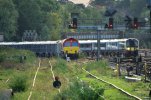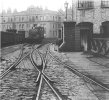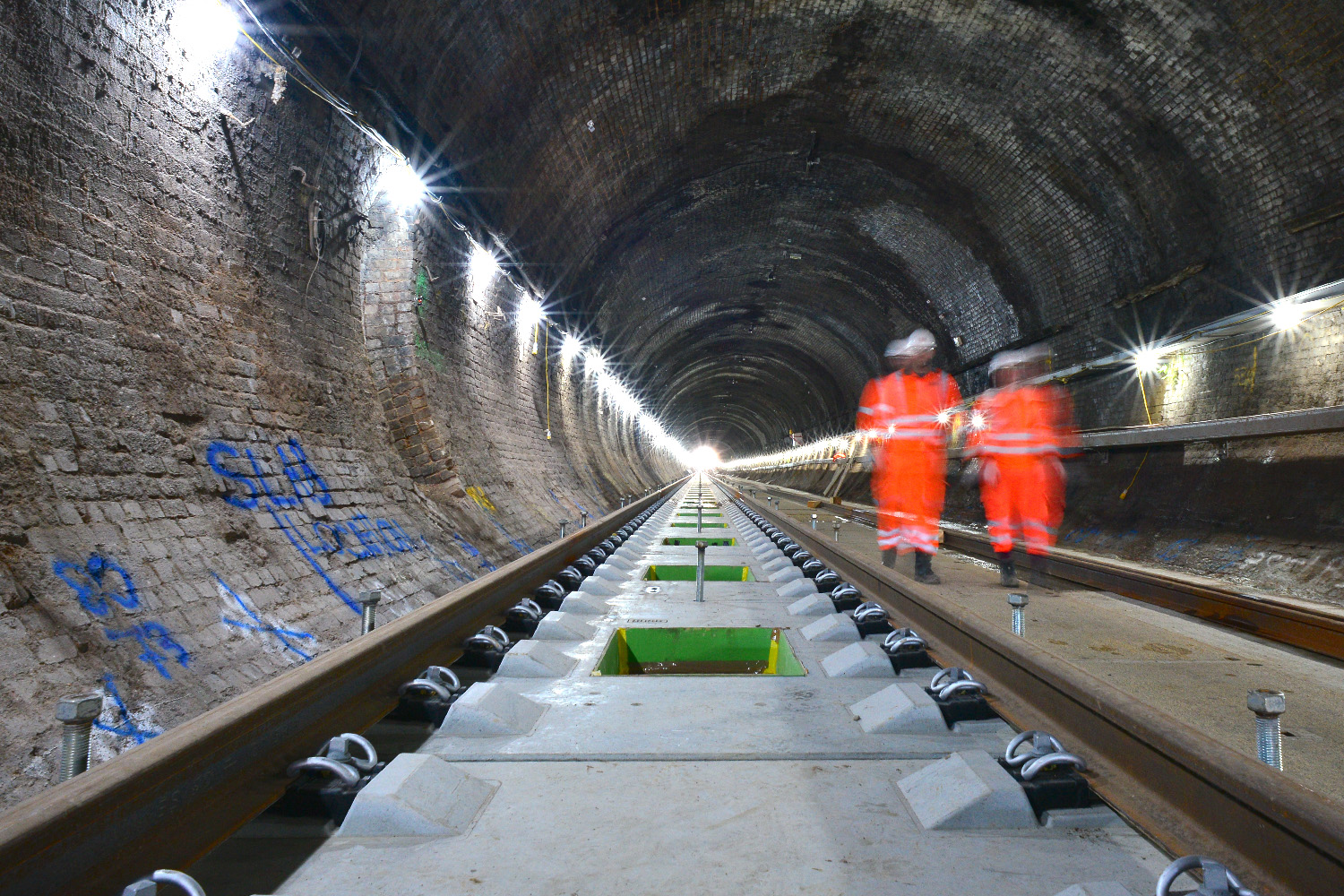-
Our booking engine at tickets.railforums.co.uk (powered by TrainSplit) helps support the running of the forum with every ticket purchase! Find out more and ask any questions/give us feedback in this thread!
You are using an out of date browser. It may not display this or other websites correctly.
You should upgrade or use an alternative browser.
You should upgrade or use an alternative browser.
Double Slips
- Thread starter Lucan
- Start date
- Status
- Not open for further replies.
Sponsor Post - registered members do not see these adverts; click here to register, or click here to log in
R
RailUK Forums
edwin_m
Veteran Member
Frog is US and modeller terminology - British railway engineers call it a crossing. Frog was however used for the junction in traditional tramway overhead wire.More vocab: the thing we call a frog, they call a Herzstuck, heart piece.
matchmaker
Established Member
Also in trolleybus overhead wiring, although these were complicated devices!Frog is US and modeller terminology - British railway engineers call it a crossing. Frog was however used for the junction in traditional tramway overhead wire.
Annetts key
Established Member
Hence why Network Rail shorten it to S&C - switch and crossing. But overall call the complete unit “points”. To differentiate a normal point from more complex pointwork, the term ‘plain lead’ is often used.Frog is US and modeller terminology - British railway engineers call it a crossing. Frog was however used for the junction in traditional tramway overhead wire.
Deepgreen
Established Member
The frogs are works of art!If you look closely you will see that they are two separate rails, albeit machined to fit together. A remarkable piece of geometry regardless!
Very common in Germany - almost unheard of here!
AlbertBeale
Established Member
Also in trolleybus overhead wiring, although these were complicated devices!
The most interesting is where you have both trolleybuses and trams mixed in, given their necessarily different wiring systems (both electrically and physically). I nearly got run down by the traffic once in Linz, Austria, standing in the middle of a road junction with a maze of overhead trolley and tram wires, admiring the complexity of the mixed-up junction arrangements for the two sorts of vehicle. But it shows what's possible! And no doubt there are lengthy German-language words for the wide variety of fittings I saw above my head...
Deepgreen
Established Member
I think this shows it (left hand line)!View attachment 110848 Then there are "Barry slips" - think there's still one in Woking Down Yard.

It's also called a 'frog' in the UK - my late father's career was on LU (as was mine) and he and his colleagues always referred to them as frogs.Frog is US and modeller terminology - British railway engineers call it a crossing. Frog was however used for the junction in traditional tramway overhead wire.
Last edited:
furnessvale
Established Member
- Joined
- 14 Jul 2015
- Messages
- 4,582
LU has had an American influence from the days of Yerkes so this is no surprise.I think this shows it (left hand line)!
View attachment 111082
It's also called a 'frog' in the UK - my late father's career was on LU (as was mine) and he and his colleagues always referred to them as frogs.
So far as BR was concerned, I never heard the term "frog" anywhere in my 12 years in the civils dept.
Ploughman
Established Member
Likewise in my 20 years on Network track renewals and 40 years at Heritage railways.LU has had an American influence from the days of Yerkes so this is no surprise.
So far as BR was concerned, I never heard the term "frog" anywhere in my 12 years in the civils dept.
The only time I heard it was with model railways.
Getting rather off topic - in Dauphin, Manitoba, it is said that some men were having problems with recalcitrant trackwork when one got a gory accident to his hand. The colleague who took him to hospital explained to the nurse that he was using a hammer and chisel to cut the nuts off a frog.
Big Jumby 74
Member
That's an interesting view, despite the weeds! It would appear to show a 'Barry slip', but this location is a few yards East of the actual Junction. My previous image, with the 66 in view, relates to an original Barry slip adjacent to the Down Portsmouth line, South-West of the junction, and probably about where the rear of the aggregate train in your view is standing. The points to which you refer (left hand road) were originally a genuine double slip albeit the right hand road (in your image) which way back use to merge at this location with the siding nearest the Down Slow Line, would appear to have been disconnected more recently....can't tell for sure, those pesky weeds again, lol !
Last edited:
Dr_Paul
Established Member
- Joined
- 3 Sep 2013
- Messages
- 1,359
One for 'Western Sunset' if I may. Are you able to comment as to the origins of the phrase 'Barry Slip' by chance? Just curious, that's all. There was also one in number 1 Siding at Wimbledon West Yard, alongside the Down Wimbledon Chase line, as it once was. Cheers.

I think I remember that one. Here's a beauty at East Smithfield depot, just off the LTSR line near Fenchurch Street. Scanned from the excellent Middleton Press book Fenchurch Street to Barking.
Requeststop
Member
Strange - only yesterday I watched a video on YouTube about three-way points; going from a single line to three lines at the same point. Are there any of these in the UK network?
furnessvale
Established Member
- Joined
- 14 Jul 2015
- Messages
- 4,582
Quite understandably, the frog bit him!Getting rather off topic - in Dauphin, Manitoba, it is said that some men were having problems with recalcitrant trackwork when one got a gory accident to his hand. The colleague who took him to hospital explained to the nurse that he was using a hammer and chisel to cut the nuts off a frog.
Strange - only yesterday I watched a video on YouTube about three-way points; going from a single line to three lines at the same point. Are there any of these in the UK network?
Yes, mostly in yards and sidings.
One at Southampton mentioned upthread (#27).Yes, mostly in yards and sidings.
swt_passenger
Veteran Member
- Joined
- 7 Apr 2010
- Messages
- 31,438
There was also a new 3 way put in at Eastleigh only about 3 or 4 years ago, it’s positioned in full view from the east end of the footbridge.One at Southampton mentioned upthread (#27).
Aren’t there also a couple at Waterloo now, leading into the main suburban side, since the 2017 works?
ABB125
Established Member
This one? https://www.google.com/maps/@50.9690312,-1.3492825,99m/data=!3m1!1e3There was also a new 3 way put in at Eastleigh only about 3 or 4 years ago, it’s positioned in full view from the east end of the footbridge.
Aren’t there also a couple at Waterloo now, leading into the main suburban side, since the 2017 works?
swt_passenger
Veteran Member
- Joined
- 7 Apr 2010
- Messages
- 31,438
That’s the one, thanks.
AlbertBeale
Established Member
Strange - only yesterday I watched a video on YouTube about three-way points; going from a single line to three lines at the same point. Are there any of these in the UK network?
Yes, mostly in yards and sidings.
These are used on the ramps leading onto the train ferries linking Sicily to the Italian mainland. I seem to remember that the initial switching to allow trains to diverge several (3?) ways as they enter the body of the boat is on the ramp attached to the land; but most of the actual divergence takes place on board. In fact I think there might be points on the ship itself too, with the middle track splitting again, so as to access a total of 4 parallel tracks on the boat.
Given the complexity of all this, it reinforces my amazement at the precision with which the boats are berthed and tied up so as to have the tracks so precisely aligned.
Class 170101
Established Member
- Joined
- 1 Mar 2014
- Messages
- 7,942
Did Kings Cross have any before its remodelling?
Yes. See the before image on this NCE Article: https://www.newcivilengineer.com/th...-track-the-kings-cross-crossovers-29-06-2021/Did Kings Cross have any before its remodelling?
Perhaps clearer in this version from Rail Engineer:

 www.railengineer.co.uk
www.railengineer.co.uk

King's Cross: Clearing the Throat and removing the hump! - Rail Engineer
Listen to this article Back in pre-COVID times, when life felt normal but hectic, Rail Engineer published an article about Network Rail’s plans to spend £1.2 billion upgrading the East Coast main line. It outlined a hugely ambitious scheme that has taken some time to plan and organise, coupled...
 www.railengineer.co.uk
www.railengineer.co.uk
LiftFan
Member
- Joined
- 27 May 2016
- Messages
- 344
There's still a double slip in the Westbury Down freight yard, recently had the 63 machines replaced with some new HW2000s! However, they're still a massive pain in the arse to maintain...
Trog
Established Member
Before it was remodelled the station throat at Euston had a lot of bullhead double slip switch diamonds, you could hardly see the sleepers for rails.
Before it was remodelled the station throat at Euston had a lot of bullhead double slip switch diamonds, you could hardly see the sleepers for rails.
and they were pigs to maintain! especially that one right off the end of the low numbered platforms, I forget the number.
They most certainly were!and they were pigs to maintain! especially that one right off the end of the low numbered platforms, I forget the number.
As a fun aside, I was once on a training course (Crewe, 1970s) during which the rather bombastic instructor declared that it was physically impossible to have switch diamonds within double slips. I mentioned that I had worked on such a set just the previous weekend, to which he replied that I clearly didn't know what I was talking about.
Off topic (perhaps there's a thread here!) he also declared with equal certainty that all geographical relay interlocking systems used latched relays, and my mention that one I worked on (AEI-GRS Watford) didn't, received a similar response. He must have thought me quite stupid!
Last edited:
ABB125
Established Member
What's the difference between a double slip and a switch diamond?As a fun aside, I was once on a training course (Crewe, 1970s) during which the rather bombastic instructor declared that it was physically impossible to have switch diamonds within double slips. I mentioned that I had worked on such a set just the previous weekend, to which he replied that I clearly didn't know what I was talking about.
Normally when two tracks cross you'll have a fixed diamond, with 4 gaps at the corners for the flanges. A switched diamond eliminates the gaps allowing higher-speed running but at the cost of essentially being two sets of stub-ended points adjacent to each other, requiring interlocking and point motors. https://upload.wikimedia.org/wikipedia/commons/f/f0/Switchdiamond.jpgWhat's the difference between a double slip and a switch diamond?
A double slip allows trains on one track to switch to the track crossing at the diamond. Because of the amount of extra metalwork involved (point blades and curved rails), a switched diamond would be very difficult to maintain and inspect. Here's a photo of a double slip with normal diamond: https://upload.wikimedia.org/wikipedia/commons/7/78/Double_slip_at_Munich_central.jpg
Here's a photo of a double slip with swtiched diamond: https://www.pinterest.co.uk/pin/328129522830439800/
- Status
- Not open for further replies.
